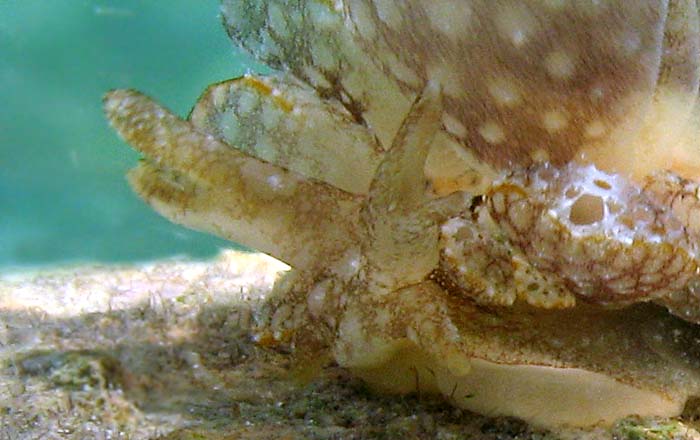This species has been observed on Reunion, Mayotte and Madagascar Islands
|

|
|
| Showing species characteristics... | Photo Philibert Bidgrain |
|
See more about : Sightening and mating periods
See more about : Cyerce pavonina mimics an encrusting ascidian
Remarks :
Identification confirmed by Bill Rudman
According Bill Rudman, our specimen from Réunion Island seems to be an intermediate between a dark form (Sth African specimen) and the more "typical" yellow-brown animals.
Synonymous : (according Worms)
- No other nam
Bibliographic data :
The body is a typical shape for a species of Cyerce with bifurcating rhinophores and the sole of the foot split in two with a transverse groove just behind the rhinophores. The body is mostly covered by large flattened paddle-shaped cerata, which are easily autotomised, and continue to wiggle and exude sticky secretions for many hours after being cast off.
The inside face of each ceras are translucent clear with many raised transparent pustules scattered all over. Each transparent pustule is surrounded by a white ring, formed from clusters of opaque white specks, possibly glands.
The outside face of each ceratas is an opaque greenish brown colour with scattered slightly raised nodules which are dull whitish in colour.
The edge of the cerata has a yellowish band and raised whitish nodules. The ceratal stalk is colourless and on the outer side there are two elongate marks, a black one close to the attachment point and a larger red one further up.
The body is translucent clear a greenish tinge, and scattered microscopic white granules. There is a dark brown band across the head, at eye level, and a lighter brown colour on the oral tentacles and rhinophores. The general colour pattern of the cerata gives the slugs the appearance of a soft coral colony, the outer face looking like contracted polyps while the inner face looks like feeding polyps.
Presence of the two "black holes' (they are not holes, just an illusion ...) near the tip of the inner face of each cerata
References :
Bill Rudman Seaslug site : Sea Slug Forum : Cyerce pavonina
Nudipixel Cyerce pavonina
Publications :
Bergh, L.S.R. (1888) Malacologische Untersuchungen. In: C.G. Semper, Reisen im Archipel der Philippinen, Wissenschaftliche Resultate. Band 2, Heft 16a., 755-814. (Pls. 77-81)
Jensen, K.R. (2007). Biogeography of the Sacoglossa (Mollusca, Opisthobranchia). Bonner Zoologische Beiträge. 55: 255–281
Other photos of Cyerce pavonina :
Philibert Bidgrain Detail from the typical yellow-brown animal from Mayotte island specimen mbouanatsa, Mayotte on the reef flat zone, less 1 m,21 October 2008, size : 20-25 mm The body is a typical shape for a species of Cyerce with bifurcating rhinophores |
 |
 |
|
Maurice Jay A few years ago... The inside face of each ceras are translucent clear with many raised transparent pustules scattered all over. Each transparent pustule is surrounded by a white ring, formed from clusters of opaque white specks, possibly glands. Presence of the two "black holes'" near the tip of the inner face of each ceras. The outer face looking like contracted polyps while the inner face looks like feeding polyps. |
 |
 |
The outside face of each ceras is an opaque greenish brown colour with scattered slightly raised nodules which are dull whitish in colour. The outer face looking like contracted polyps while the inner face looks like feeding polyps. |
Philibert Bidgrain Mayotte, Mtsanga Mbouanatsa, less 1 m, 6 October 2012, size : 30 mm The edge of the cerata of this specimen hasn't a yellowish band but raised with whitish nodules (a).
|
 |
 |
Jacques Vieira Madagascar, Nosy Bé |
More photos from Indian Ocean
See more about : Cyerce pavonina mimics an encrusting ascidian
Réunion, Cyerce pavonina, at saint Gilles, by Christophe Cadet.
